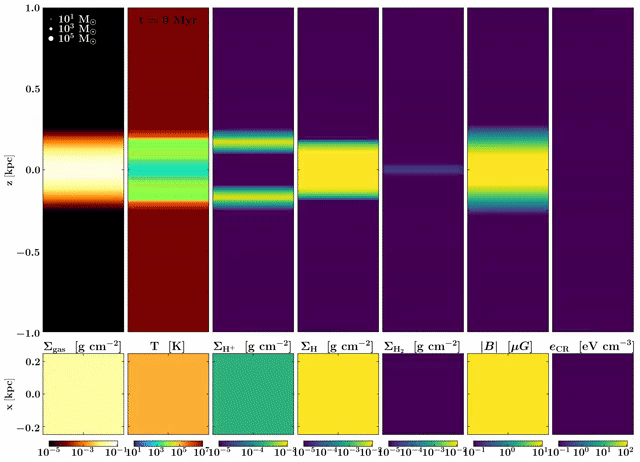SILCC VII - Gas kinematics and multiphase outflows of the simulated ISM at high gas surface densities
Tim-Eric Rathjen
Galactic outflows are unambiguously important in shaping the evolution of galaxies and could be a major agent in the regulation of star formation. Understanding the multiphase nature, the kinematic structure, and the magnitude of galactic outflows is imperative to inform subgrid models for larger-scale cosmological simulations and successfully interpret observations. Within the SILCC project, we are using highly sophisticated magnetohydrodynamics (MHD) simulations of the turbulent and multiphase interstellar medium (ISM) to model origin of those galactic outflows and investigate the main agents which launch them. We are incorporating all major thermal and non-thermal ISM processes and stellar feedback channels like non-equilibrium chemistry, self-gravity, stellar winds from massive stars, hydrogen-ionising UV radiation, core-collapse supernovae and acceleration and anisotropic diffusion of cosmic rays (CRs). We investigate the impact of those ISM processes with a special emphasis on the effects of CRs on the capability to launch galactic outflows. By carrying out a set of simulations over a range of varying initial gas surface densities between Σgas = 10 - 100 M☉ pc-2, we can model different galactic environments.
CRs have a significant impact on the gas phase structure of galactic outflows as they enable the acceleration of cold (T < 300 K) and potentially molecular gas up to heights of 2 kpc from the galactic midplane with mass loading factors of order unity, even in periods of low star formation rates. Without CRs, the outflow is exclusively launched from the hot gas phase (T > 3 x 105 K) generated by overlapping supernova bubbles and lacks the cold gas component entirely.
Focusing on the kinematic structure of the gas, we find a correlation of the star formation rate surface density with the vertical velocity dispersion of the warm ionised medium (WIM), as well as with the cold neutral medium (CNM) (see Fig. 1). We do not find a correlation between star formation rate and velocity dispersion in the absence of stellar feedback. The velocity dispersion of the WIM is a factor ~2.2 higher than that of the CNM, in agreement with local observations. For ΣSFR > 1.5 x 10-2 M☉ yr-1 kpc-2 the WIM motions become supersonic. Our results indicate that the source of turbulence in the ISM can be attributed to the complex interplay of stellar feedback, stellar feedback-driven and CR-supported outflows, and gravitational instabilities.
Rathjen et al., 2022, arXiv:2211.15419, submitted to MNRAS

